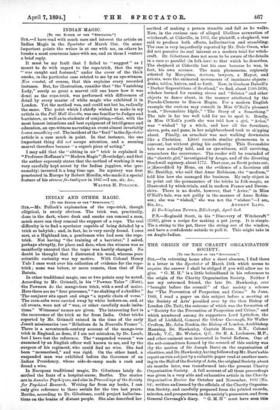INDIAN MAGIC.
[To THE ETITOR 07 THE "aramroa...]
Sra,—I have read with much care and interest the article on Indian Magic in the Spectator of March 31st. On some important points the writer is at one with me, on others he breaks a most courteous lance with me, and on these I venture a brief reply.
It must be my fault that I failed to " suggest " as I meant to do with regard to the rope-trick, that the rope " was caught and fastened," under the cover of the thick ;smoke, in the particular case related to me by an eye-witness. Non constat, of course, that this explains every recorded instance. But, for illustration, consider that "the Vanishing Lady," surely as great a marvel (till one knew how it was done) as the rope-trick, was performed with differences of -detail by every master of white magic who exhibited it in London. Yet the method was, and could not but be, radically the same. The point which I chiefly wished to make in my article in the Pall Mall Gazette, was one familiar to Judges and barristers, as well as to students of conjuring,—that, with the inost honest intentions and best equipment of intelligence and -education, an eye-witness narrating an event almost invariably leaves something out. The incident of the "frail" in the Spectator article is a case much in point. In that instance, the one important thing did not escape attention, and a seeming marvel therefore became "a superb piece of acting."
I may add that the "sitting in air" trick is explained in "Professor Hoffman's" "Modern Magic" (Routledge), and that the author expressly states that the method of working it was very carefully kept secret by the Indian jugglers, who (pre- sumably) invented it a long time ago. Its mystery was first penetrated in Europe by Robert Houdin, who made it a special -feature of his shames fantastiques in 1847.-1 am, sir, &c., WALTER H. POLLOCK.






































 Previous page
Previous page